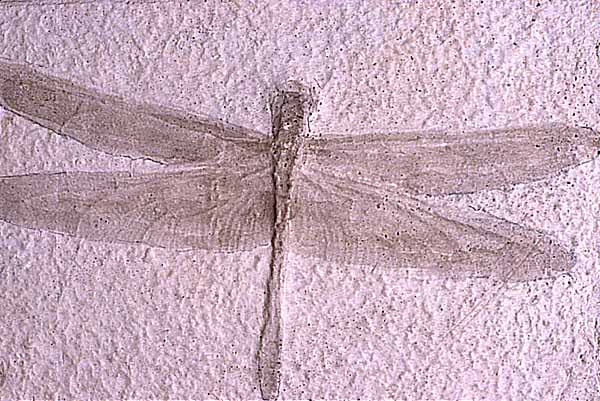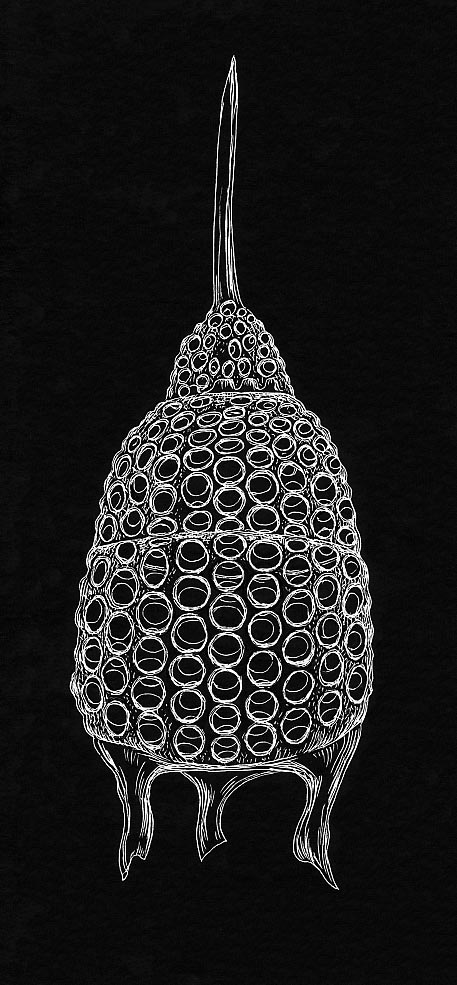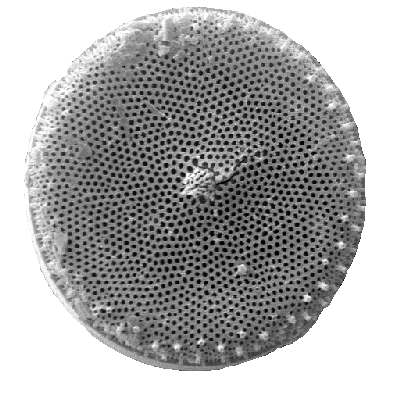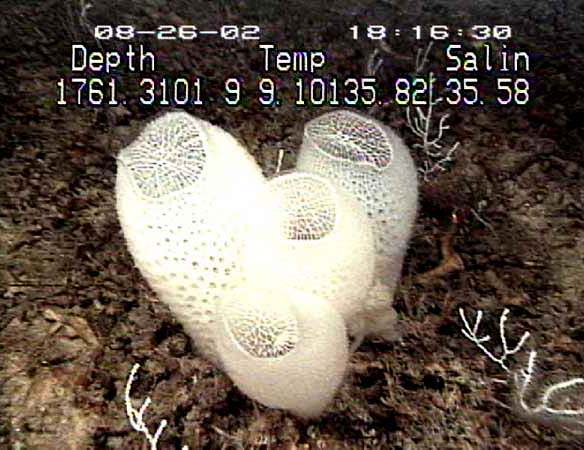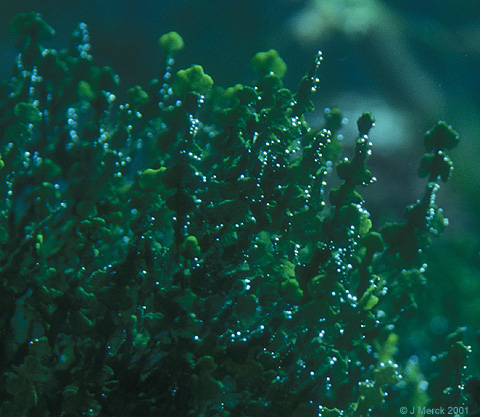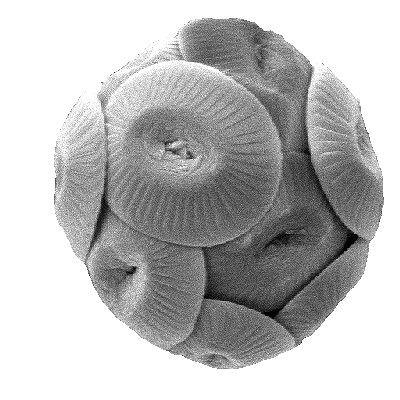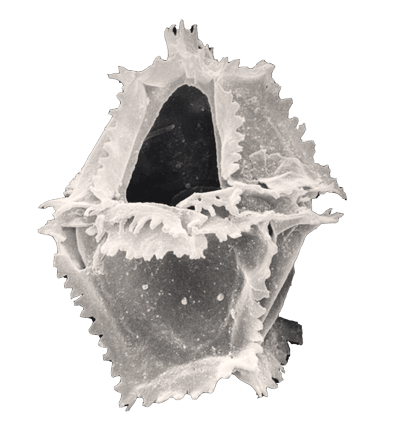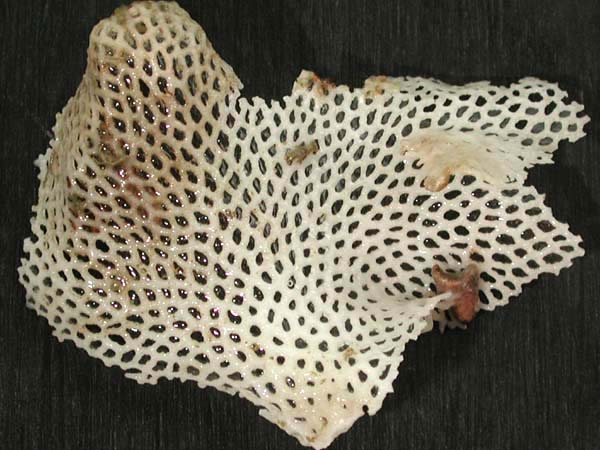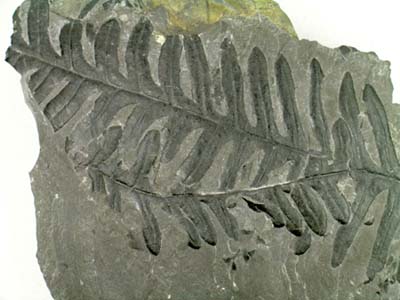Taphonomy I: Properties and Habitats of Good Fossil Makers
Taphonomy: The realm of paleontology dedicated to the study of the processes by which an organism becomes part of the fossil record. Yields an understanding of the filters and biases of the fossil record.
Becoming a fossil:
From the birth of the organism to discovery by a paleontologist, fossils go through four general stages.
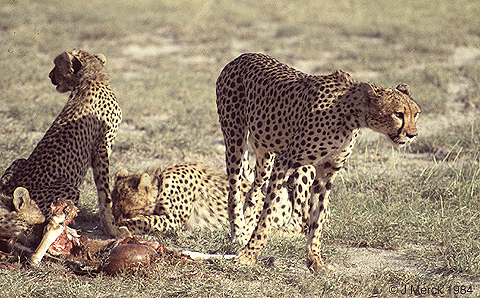
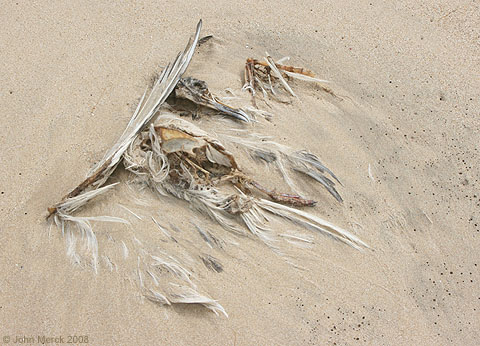
- Decomposition: destruction of soft tissues (mostly by bacteria)
- Disassociation: hard parts become separated
- Abrasion: surface details of hard parts lost
- Breakage: hard parts degraded into fragments
- Winnowing: fragments sorted by size due to moving water
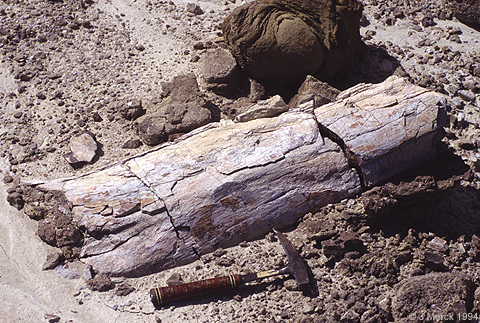
- Dissolution: hard parts chemically altered into soluble substances
- Compaction: remains crushed by overlying sediment
- Recrystallization: ground water & minerals enter, form crystals & disrupt remains
Investigative stage: Discovery to ultimate destruction. Every day, fossils are unearthed by erosion, only quickly to be destroyed by it. To enter the fossil record, as scholars understand it, a fossil must be exhumed (usually by natural processes), discovered, and described.
The selection of fossils for inclusion in the fossil record is non-random. Each stage imposes filters and biases. These will be explored in a later lecture. For now, we concentrate on the most fundamental filter: Not all clades of organisms produce preservable hard parts. Although soft bodied organisms can produce fossils under special (konservat-lagersätten) situations to be considered later. a first-order approximation is that only creatures that make hard parts during life have any hope of becoming fossils. Only a short list of suitable hard substances are produced by organisms.
Main hard substances found in organisms:
Calcareous skeletons are thought to have originated at least twenty times in eukaryote evolution. Also the first biomineral skeletons known, dating to 750 m.a. Typically secreted extracellularly. The abundance of independent origins suggests the exaptation (coopting) of an underlying biochemical mechanism present in soft-bodied precursors such as:
- Biochemistry for transport of Ca2+ ions.
- Biochemistry for prevention of "accidental" external calcification, a danger in times of high CaCO3 saturation.
- Silica - SiO2 (mostly in the form of cryptocrystalline quartz or Opal - hydrated silica - SiO2 - nH2O ). Less widely distributed, with at least eight independent origins. Silica and opal are secreted intracellularly, in vesicles possibly derived from golgi bodies. Thus almost all silica secreting organisms are unicellular.
- Calcium phosphates such as apatite - Ca5(PO4)3
In stark contrast to silica, appears exclusively in animals, mostly brachiopods (left) and vertebrates. Not surprising since PO43- ion is a relatively scarce nutrient that one might prefer not to "waste" on skeleton construction. Accordingly, vertebrates, who make the most extensive use, have skeletons that are constantly being remodeled by resorbtion, allowing the metabolism frequent access to the PO43-. The biochemistry of phosphate precipitation seems to be linked with that of calcium carbonate. Indeed, carbonate substrates have been used surgically as bases for bone regeneration.
- Complex organic molecules forming the framework for robust soft tissues: While not exactly "hard parts" some soft tissues form tough parts with reasonably good fossilization potentials. These include:
- Chitin (a sugar) - the basis of arthropod cuticle.
- Cellulose (a sugar) - the foundation of vascular plant skeletons
- Lignin (a sugar) - the basis of woody tissue
- Spongin (a protein) - the basis of the structural tissue of most sponges
- Keratin (a protein) - the primary molecule of animal skin and integument
List of some of the major clades producing common body fossils:
(Classifications used here largerly follow these on the UMCP website)
Organisms with silicious skeletons
-
Radiolaria: (Cambrian - rec.)
- Planktonic, microscopic
- Opaline (i.e.hydrated silica) skeletons
- Biostratigraphically significant? - Yes
- Volumetrically significant? - No
- Significant binder of sediment? - No Except as source of dissolved silica precipitating as chert.
- Planktonic, microscopic
- Shells are two-pieced frustules (like little pillboxes), made of opal
- Accumulations produce sediment called diatomaceous earth
- Biostratigraphically significant? - Yes
- Volumetrically significant? - No
- Significant binder of sediment? - No
- Hard parts include calcareous, siliceous, and spongin spicules
- Hexactinellid sponges have distinctive silicious skeletons.
- Biostratigraphically significant? - Sometimes
- Volumetrically significant? - No
- Significant binder of sediment? - in some environments
Organisms with calcareous skeletons
-
Foraminfera: (Cambrian - rec.)
- Include benthic and (derived) planktonic forms
- Barely macroscopic (must use microscope to see details)
- Basal members with agglutinated skeletons, more derived with calcareous tests
- Extraordinarily abundant in marine record
- Biostratigraphically significant? - Yes
- Volumetrically significant? - No
- Significant binder of sediment? - No
- Dasycladales: (Ediacaran - rec.) Include
- Receptaculitids, (Cambrian - Permian) a strictly Paleozoic group of dasyclades and important reef former
- Living macroscopic unicellular taxa such as Acetabularia.
- Biostratigraphically significant? - No
- Volumetrically significant? - No
- Significant binder of sediment? - No
- "Calcareous algae:" Taxonomically diverse array with calcareous skeletons.
- Benthic marine green algae with skeleton of calcite or aragonite
- Broken down dasyclade skeletal fragments are a major component of limestones
- Biostratigraphically significant? - No
- Volumetrically significant? - Yes
- Significant binder of sediment? - Yes
- Planktonic, extraordinarily small forms
- Skeleton comprised of many individual clacareous plates called coccoliths
- Accumulations of coccoliths form the rock chalk. Thus
- Biostratigraphically significant? - Yes
- Volumetrically significant? - Yes
- Significant binder of sediment? - No
- Planktonic, some parasitic (including zooxanthellae)
- Microscopic
- Normal test is cellulose; have a calcareous cyst stage
- Biostratigraphically significant? - Yes
- Volumetrically significant? - No
- Significant binder of sediment? - No
- Hard parts include calcareous, siliceous, and spongin spicules
- With exception of hexactinellids, all important fossil sponges are calcareous.
- Biostratigraphically significant? - Sometimes
- Volumetrically significant? - Yes
- Significant binder of sediment? - Yes
- Benthic epifaunal sessile suspension feeders
- Majority of cnidarians are not coralline
- Biostratigraphically significant? - Yes
- Volumetrically significant? - Sometimes
- Significant binder of sediment? - Yes
- Exclusively colonial, benthic, epifaunal, sessile suspension feeders
- Some forms lack hard skeleton; those that have them are calcareous
- Minor components of many reef systems
- Biostratigraphically significant? - Yes
- Volumetrically significant? - No
- Significant binder of sediment? - Yes
- Solitary benthic suspension feeders, strictly marine
- Two hard valves surrounding most body tissue
- Hard parts are calcite in all forms except lingulates
- Phenomenal fossil record; modern diversity much lower than Paleozoic diversity
- Biostratigraphically significant? - Yes
- Volumetrically significant? - No
- Significant binder of sediment? - No
- Extremely significant, extremely diverse clade of (almost all motile) animals
- Most forms have shells (single, double, or eight) made of aragonite (i.e. calcareous)
- Biostratigraphically significant? - Yes
- Volumetrically significant? - At some times in geologic history
- Significant binder of sediment? - No
- Displays stereom, complex calcitic skeletal tissue in which each element is a single calcite crystal, permeated with perforations.
- Strictly marine, macroscopic, almost all epifaunal
- Biostratigraphically significant? - Yes
- Volumetrically significant? - Yes
- Significant binder of sediment? - No
Coccolithophorida: (Jurassic - rec.)

Calcareous sponge
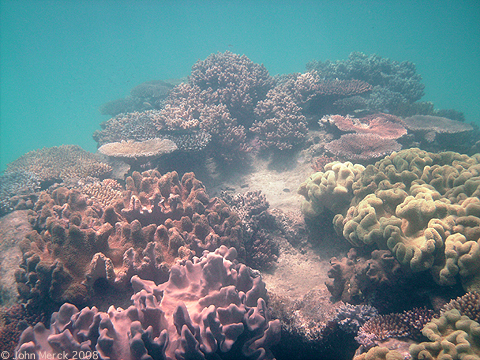
Mackay Reef, Queensland, Australia
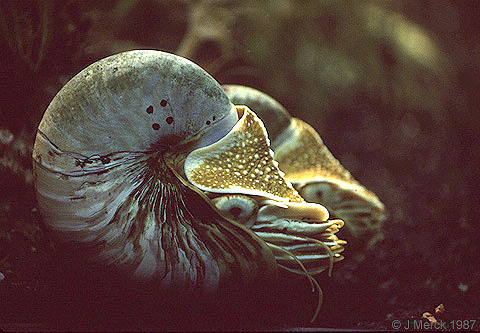
Chambered nautilus
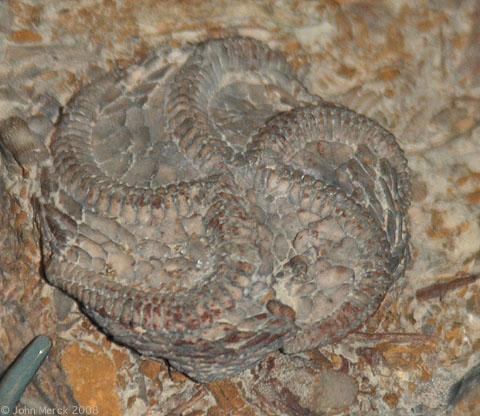
The edrioasteroid Foerstediscus splendens
Organisms with phosphatic skeletons
- Basalmost forms have few hard parts
- Primitive forms have exoskeleton of bone, endoskeleton of cartilage
- Derived forms ossify the endoskeleton and reduce the exoskeleton
- Other hard tissues include enamel. and dentine - originally found in both teeth and dermal armor
- Biostratigraphically significant? - Yes
- Volumetrically significant? - No
- Significant binder of sediment? - No
- The classic facies fossil or paleoenvironmental marker - in this case, lingulates have inhabited tidal mud flats since the Cambrian
- Primitive in many respects compared to other brachiopods
- In contrast to other brachiopods, harden their valves with calcium phosphate
- Biostratigraphically significant? - No
- Volumetrically significant? - No
- Significant binder of sediment? - No

Conodont elements (image source unknown)
Lingulate Brachiopoda: (Cambrian - rec.)
Organisms with "tough tissues"
- Plantae: (Ordovician - rec.)
- True plants: terrestrial (or secondarily aquatic) multicellular chlorophytes
- Hard parts (including wood, stems, leaves, spores, pollen, seeds, fruit, flowers, depending on the clade) are cellulose
- Form coal under certain circumstances - volumetrically significant part of rock record and economically significant.
- Seed-plant pollen is extremely important as index fossils
- Biostratigraphically significant? - Yes
- Volumetrically significant? - Yes
- Significant binder of sediment? - Yes
Arthropoda: (Cambrian - rec.)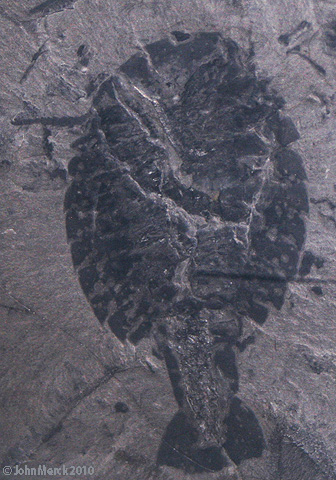
Sidneyia inexpectans- Extremely common, diverse clade of (predominantly) motile animals
- Skeleton consists of an external cuticle based on chitin, a material with mediocre preservation potential.
- But there are so many. Arthropods grow by ecydysis, so a single individual produces many potential fossils
- Exceptions:
- Trilobites (Cambrian - Permian) calcified their skeletons, giving them an excellent record.
- Barnacles (Ordovician - Permian) attach to the substrate and secrete calcite plates.
- Biostratigraphically significant? - Yes
- Volumetrically significant? - No
- Significant binder of sediment? - No





.jpg)
